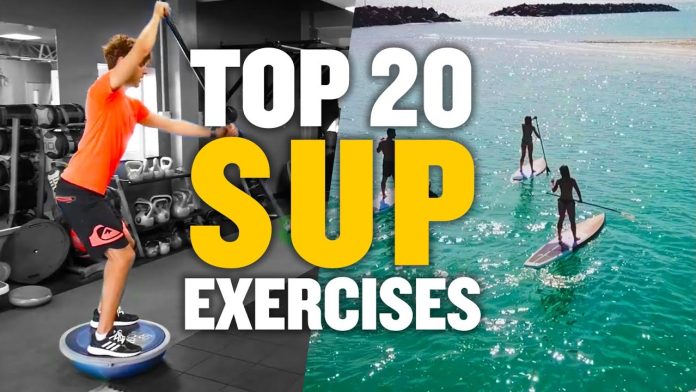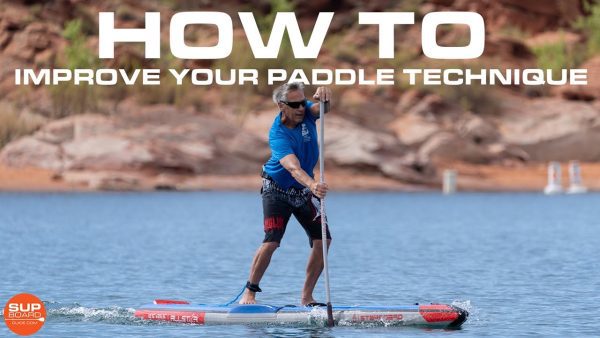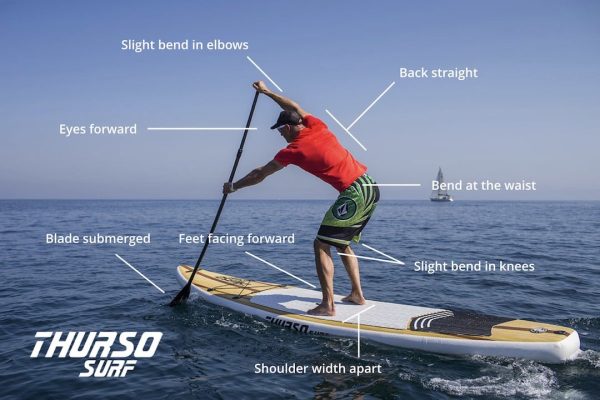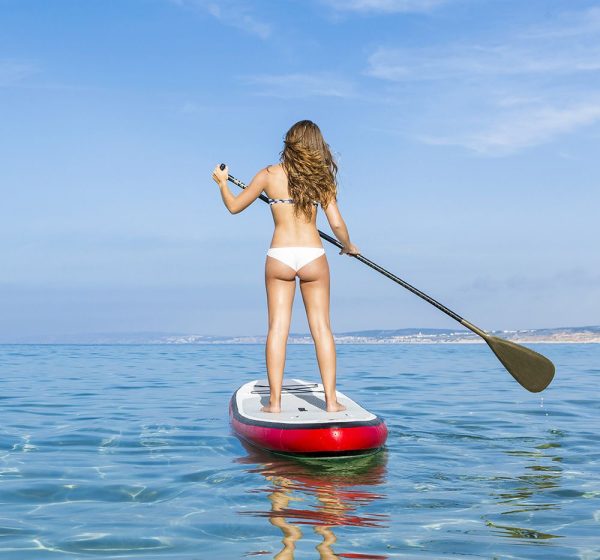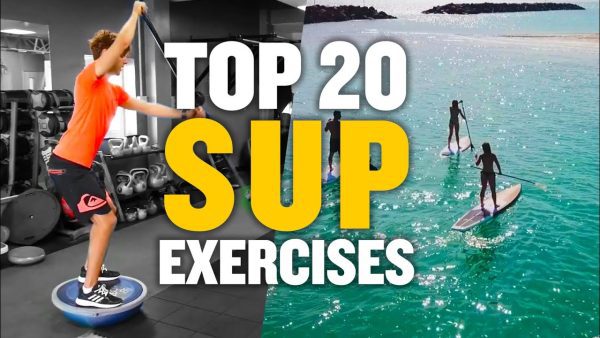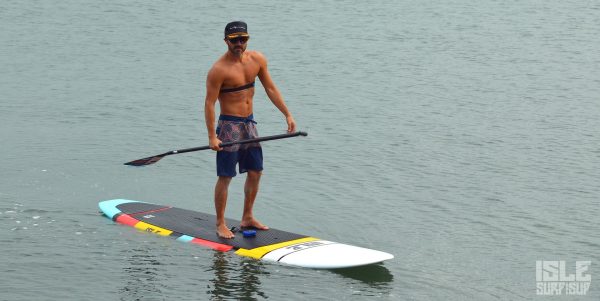Looking to boost your strength and power on the stand-up paddleboard? If you’re wondering how to take your SUP paddling to the next level, you’ve come to the right place. In this article, we’ll uncover some effective tips and techniques to help you increase your strength and endurance, allowing you to paddle longer, faster, and with more confidence. So, if you’re ready to enhance your SUP skills and tackle those challenging waters effortlessly, read on!
Improving Technique
When it comes to becoming a stronger paddleboarder, one of the most important factors to consider is your technique. Proper paddle position, stroke technique, and body positioning are key components that can greatly enhance your performance on the water.
Paddle Position
Finding the optimal paddle position is crucial in maximizing your efficiency and power during each stroke. To achieve this, start by holding your paddle with both hands shoulder-width apart. Your top hand should grip the handle while the bottom hand rests on the shaft, slightly lower than the top hand.
During the stroke, make sure to fully submerge the paddle blade in the water, allowing it to catch the water and propel you forward. By maintaining a proper paddle position, you’ll be able to generate more power and paddle more efficiently, ultimately improving your strength and endurance.
Stroke Technique
Having a solid stroke technique is essential for effective paddleboarding. It involves proper paddle entry, engaging your core, and using your entire upper body to generate power. Start by extending your top arm forward, reaching as far as you comfortably can without straining. Simultaneously, rotate your torso to engage your core muscles.
Once your paddle is fully submerged, use your core and upper body to pull the paddle through the water towards the tail of the board. As you complete the stroke, exit the water smoothly and repeat the movement on the opposite side. Focusing on proper stroke technique will not only make you a stronger paddler but will also prevent injury and promote a more enjoyable paddling experience.
Body Positioning
Finding the ideal body positioning on your paddleboard is essential for maximizing your strength and stability. Stand with your feet hip-width apart, ensuring a stable base to support your movements. Distribute your weight evenly between both feet, engaging your core and keeping your back straight.
As you paddle, maintain an upright posture and avoid hunching forward. This will help optimize your body’s alignment, allowing you to generate more power through each stroke. By understanding and implementing proper body positioning, you’ll be able to paddle with greater strength and efficiency.
Building Core Strength
A strong core is the foundation of a powerful paddleboarding technique. It provides stability, balance, and the ability to transfer force from your lower body to your upper body. Here are some exercises that can help you strengthen your core and enhance your paddleboarding performance:
Plank Exercises
Planks are an excellent core-strengthening exercise that targets multiple muscle groups simultaneously. Start by getting into a push-up position, resting on your forearms instead of your hands. Keep your body in a straight line from head to toe, engaging your core muscles to hold the position for as long as you can. Repeat this exercise for multiple sets, gradually increasing your holding time to challenge your core muscles further.
Russian Twists
Russian twists are a great exercise for targeting both your core and oblique muscles. Sit on the ground with your knees bent and feet lifted off the floor. Lean back slightly, engage your core, and twist your torso from side to side, touching the ground on each side with your hands. To increase the difficulty, you can hold a weighted object such as a medicine ball or a dumbbell during the exercise. Aim to perform multiple sets of 10-15 repetitions.
Mountain Climbers
Mountain climbers are a dynamic exercise that engages your core, shoulders, and legs. Start in a high plank position with your hands directly under your shoulders. Drive one knee towards your chest while keeping the other leg extended. Alternate between legs in a running motion while maintaining a steady pace. Aim to perform multiple sets of 20-30 seconds, gradually increasing the duration as your core strength improves.
By incorporating these core-strengthening exercises into your workout routine, you’ll develop a solid foundation of strength to enhance your paddleboarding skills and endurance.
This image is property of i.ytimg.com.
Increasing Endurance
Building endurance is crucial for maintaining stamina and paddling longer distances without fatigue. Here are some effective strategies to help you increase your endurance on the water:
Interval Training
Interval training involves alternating between periods of high-intensity exercise and short recovery periods. This type of training is highly effective in building endurance and improving cardiovascular fitness. To incorporate interval training into your paddleboarding routine, try paddling at a fast pace for a set distance or time, followed by a slower recovery pace. Repeat this cycle multiple times, gradually increasing the intensity and duration of the high-intensity intervals.
Long Distance Paddles
To build endurance, it’s important to gradually increase the distance you paddle. Start by setting achievable goals for longer paddles and aim to gradually increase the distance each time. Focus on maintaining a consistent pace and rhythm, using efficient paddle technique to conserve energy. Regularly challenging your endurance with longer paddles will help you build stamina and improve your overall performance on the water.
Cross-training
Incorporating other forms of cardiovascular exercise into your training routine can greatly benefit your paddleboarding endurance. Activities such as running, cycling, or swimming engage different muscles and cardiovascular systems, providing a well-rounded approach to fitness. By cross-training, you’ll improve your overall endurance and be better equipped to tackle longer paddles with ease.
By implementing these strategies into your training routine, you’ll gradually increase your endurance, allowing you to enjoy longer and more challenging paddleboarding adventures.
Enhancing Upper Body Strength
A strong upper body is essential for generating power, propelling yourself through the water, and maintaining stability. Here are some exercises that target the muscles of the upper body:
Push-ups
Push-ups are a classic exercise that targets multiple upper body muscles, including the chest, shoulders, and triceps. Start in a high plank position with your hands slightly wider than shoulder-width apart. Lower your body towards the ground, keeping your elbows close to your sides. Push back up to the starting position, engaging your chest and tricep muscles. Aim to perform multiple sets of 10-15 repetitions, gradually increasing the number of reps as you build strength.
Bicep Curls
Bicep curls are effective for strengthening the muscles in the front of your upper arms. Stand with a dumbbell in each hand, palms facing forward. Keep your elbows close to your sides as you raise the dumbbells towards your shoulders, contracting your biceps. Slowly lower the dumbbells back down to the starting position. Aim to perform multiple sets of 10-15 repetitions, gradually increasing the weight as you progress.
Tricep Dips
Tricep dips target the muscles on the back of your upper arms, providing strength and stability for your paddle strokes. Sit on a stable surface such as a bench or step, with your hands gripping the edge and your fingers pointing forward. Extend your legs out in front of you, keeping your knees slightly bent. Lower your body by bending your elbows, then push back up to the starting position. Aim to perform multiple sets of 10-15 repetitions, gradually increasing the difficulty by elevating your feet or adding weights.
By incorporating these upper body exercises into your training routine, you’ll strengthen the muscles necessary for powerful paddle strokes and improved stability on your paddleboard.
This image is property of cdn.thursosurf.com.
Improving Lower Body Strength
Strong lower body muscles are important for maintaining balance, stability, and generating power while paddleboarding. Here are some exercises to help strengthen your lower body muscles:
Squats
Squats are a compound exercise that targets multiple lower body muscles, including the quadriceps, hamstrings, and glutes. Start by standing with your feet shoulder-width apart. Lower your body by bending your knees and pushing your hips back, as if you were sitting in an imaginary chair. Keep your weight in your heels and your chest lifted. Push through your heels to return to the starting position. Aim to perform multiple sets of 10-15 repetitions, gradually increasing the depth and difficulty as you build strength.
Lunges
Lunges are another effective exercise for strengthening the muscles in your legs and improving overall lower body strength. Start by standing with your feet hip-width apart. Take a step forward with your right foot, lowering your body by bending both knees. Your front knee should be directly above your ankle, and your back knee should hover just above the ground. Push through your front heel to return to the starting position, then repeat the exercise with your left leg. Aim to perform multiple sets of 10-15 repetitions on each leg, gradually increasing the difficulty as you progress.
Calf Raises
Calf raises target the muscles in your calves, which play a crucial role in maintaining balance and stability on your paddleboard. Stand with your feet hip-width apart, and slowly rise up onto the balls of your feet, lifting your heels as high as you can. Hold for a moment, then lower your heels back down to the ground. For an added challenge, perform calf raises on an elevated surface, such as a step. Aim to perform multiple sets of 10-15 repetitions, gradually increasing the intensity as your lower body strength improves.
By incorporating these lower body exercises into your training routine, you’ll develop stronger legs, enhancing your stability and overall paddleboarding performance.
Maintaining Proper Hydration
Proper hydration is crucial for maintaining energy levels, preventing muscle cramps, and promoting overall health on and off the water. Here are some tips to help you stay properly hydrated during your paddleboarding adventures:
Importance of Hydration
Water is essential for regulating body temperature, lubricating joints, and transporting nutrients throughout your body. When paddleboarding, your body loses fluids through evaporation and sweat, leading to dehydration if not properly replenished. Dehydration can negatively impact your performance and increase the risk of fatigue, muscle cramps, and heat-related illnesses. It’s important to prioritize hydration before, during, and after your paddleboarding sessions.
Hydration Techniques
To stay properly hydrated, it’s recommended to drink water before heading out on the water, aiming to consume at least 16 ounces. During your paddleboarding session, continue to drink water at regular intervals, even if you don’t feel thirsty. Opt for a hydration pack or a water bottle that can be easily accessed while on the water. To prevent dehydration, make it a habit to take small sips of water every 15-20 minutes.
Electrolyte Replacement
When you sweat, your body not only loses water but also essential electrolytes like sodium, potassium, and magnesium. These electrolytes play a vital role in maintaining proper hydration and muscle function. To replenish electrolytes, consider drinking sports drinks or incorporating electrolyte tablets or powders into your water. These products can help restore the balance of electrolytes in your body and prevent fatigue and muscle cramps.
By prioritizing proper hydration before, during, and after your paddleboarding adventures, you’ll ensure optimal performance, endurance, and overall well-being on the water.
This image is property of www.shape.com.
Working on Flexibility
Flexibility is key in paddleboarding as it allows for a greater range of motion and reduces the risk of injury. Incorporating stretching exercises, yoga, and foam rolling into your routine can greatly improve your flexibility and overall paddling experience.
Stretching Exercises
Before and after your paddleboarding sessions, take the time to perform stretching exercises that target the muscles used during paddling. Focus on stretching your shoulders, chest, back, hips, and legs. Aim to hold each stretch for 30-60 seconds, breathing deeply and relaxing into the stretch. Stretching not only improves flexibility but also helps warm up your muscles before paddling and aids in recovery afterward.
Yoga
Yoga is an excellent practice for improving flexibility, strength, and balance – all of which are essential for paddleboarding. Consider incorporating yoga into your weekly routine, either through virtual classes or by following online tutorials. Yoga poses such as downward dog, warrior series, and pigeon pose can help stretch and strengthen the muscles used in paddleboarding, enhancing your overall performance on the water.
Foam Rolling
Foam rolling is a self-massage technique that helps release muscle tension, improve flexibility, and overall muscle recovery. Before and after paddleboarding, use a foam roller to target and roll out tight muscles in your back, shoulders, legs, and hips. Slowly roll back and forth over areas of tension, applying gentle pressure. Foam rolling can help alleviate any muscle soreness or tightness, allowing you to move more freely and comfortably on your board.
By incorporating these flexibility-enhancing practices into your routine, you’ll improve your range of motion, reduce the risk of injuries, and enjoy a more fluid and effortless paddling experience.
Implementing Interval Training
Interval training, as mentioned earlier, is a highly effective technique for improving endurance and overall fitness. Let’s dive deeper into the benefits of interval training, common interval training techniques, and a sample interval training workout for paddleboarding.
Benefits of Interval Training
Interval training is a time-efficient exercise method that offers numerous benefits. Not only does it improve cardiovascular fitness and endurance, but it also helps burn calories, increase metabolism, and build lean muscle mass. By alternating between high-intensity and recovery periods, interval training pushes your body’s limits and stimulates adaptations that promote increased stamina and overall performance.
Interval Training Techniques
When it comes to interval training for paddleboarding, there are various techniques you can implement to challenge your cardiovascular system and improve endurance.
1. Time-Based Intervals: Set a timer and paddle at a high intensity for a designated period, followed by a shorter recovery period. For example, paddle at a fast pace for 2 minutes, then paddle at a slower pace for 1 minute to recover. Repeat this cycle for a specific number of rounds.
2. Distance-Based Intervals: Choose a distance to paddle at a fast pace, followed by a less intense recovery paddle. For instance, paddle at a fast pace for 500 meters, then reduce the intensity for 250 meters to recover. Repeat this cycle for several rounds, gradually increasing the distance of the high-intensity intervals.
3. Pyramid Intervals: Begin with short high-intensity efforts, gradually increasing the duration, before descending back down. For example, paddle at a fast pace for 30 seconds, recover for 15 seconds, paddle for 45 seconds, recover for 30 seconds, paddle for 1 minute, recover for 45 seconds, then work your way back down.
Interval Training Workout
For a sample interval training workout, try the following:
- Warm up by paddling at an easy pace for 10 minutes.
- Perform 5 rounds of 2 minutes of paddling at a fast pace, followed by 1 minute of paddling at a slower pace to recover.
- Cool down by paddling at an easy pace for 5 minutes.
Remember to listen to your body and adjust the intensity and duration of the intervals according to your fitness level. Gradually increase the intensity and duration over time as you become fitter and more comfortable with interval training.
By incorporating interval training into your paddleboarding routine, you’ll improve your cardiovascular fitness, endurance, and ability to sustain a faster pace for longer periods.
This image is property of i.ytimg.com.
Using Resistance Training
Incorporating resistance training into your paddleboarding routine can strengthen your muscles, enhance power output, and improve overall performance. Here are ways to use resistance training effectively:
Resistance Bands
Resistance bands are a versatile and portable tool that can be incorporated into various exercises. By attaching a resistance band to an anchor point or stepping on it with your feet, you can perform exercises that target specific muscle groups used in paddleboarding, such as rows, shoulder presses, and bicep curls. The resistance provided by the bands challenges your muscles, promoting strength and stability.
Weighted Exercises
Using weighted objects such as dumbbells, kettlebells, or medicine balls can help increase the resistance and intensity of your exercises. Incorporate exercises like squats, lunges, shoulder presses, and bent-over rows using weights to target the major muscle groups used in paddleboarding. Start with lighter weights and gradually increase the load as your strength improves. Remember to maintain proper form and technique to prevent injury.
Cable Machines
If you have access to a gym or a cable machine, take advantage of the variety of exercises it offers. Cable machines provide constant tension throughout the movement, engaging your muscles effectively. Perform exercises like cable rows, chest presses, and tricep pushdowns to strengthen the muscles essential for paddleboarding. Experiment with different attachments and cable heights to target specific muscle groups.
By incorporating resistance training into your routine, you’ll improve your overall strength, power, and stability, leading to enhanced performance and enjoyment on the water.
Seeking Professional Guidance
While improving your paddleboarding skills and fitness can be achieved through self-guided methods, seeking professional guidance can greatly accelerate your progress and ensure safe and effective training. Consider the following options:
SUP Lessons
Taking stand-up paddleboarding lessons from a certified instructor can help you refine your technique and optimize your performance. Instructors can provide valuable feedback, correct any form or technique issues, and teach you advanced skills to enhance your paddling abilities. Additionally, they can offer guidance on safety practices, equipment selection, and local paddling recommendations. SUP lessons are a great investment for both beginners and experienced paddlers looking to improve their skills.
Personal Trainer
Hiring a personal trainer who specializes in paddleboarding or water sports can provide personalized guidance tailored to your specific needs and goals. A trainer can assess your current fitness level, develop a customized training plan, and guide you through exercises and workouts that target the muscles and skills necessary for paddleboarding. They can also monitor your progress, provide motivation, and make adjustments to your training plan as needed. A personal trainer can be especially beneficial if you have specific limitations, injuries, or performance goals.
Group Training
Joining a paddleboarding or water sports training group can provide a supportive and motivating environment to improve your skills. Group training sessions often incorporate a variety of exercises, drills, and workouts designed to enhance specific aspects of paddleboarding. Working out with others who share similar goals can be inspiring and offer a sense of community. Additionally, training groups may include experienced paddlers and coaches who can provide guidance and mentorship.
By seeking professional guidance, whether through lessons, personal training, or group training, you’ll have access to expert knowledge and guidance, enabling you to progress more efficiently and safely on your journey to becoming a stronger and more skilled paddleboarder.
In conclusion, improving your strength and skills in stand-up paddleboarding requires a holistic approach that includes refining your technique, building core and upper body strength, increasing endurance, enhancing lower body strength, maintaining proper hydration, working on flexibility, implementing interval training, using resistance training, and seeking professional guidance. By incorporating these strategies into your paddleboarding routine, you’ll not only become a stronger paddler but also enhance your overall performance, enjoyment, and safety on the water. So grab your paddle, hit the water, and unleash the full potential of your paddleboarding journey!
This image is property of www.supworldmag.com.

